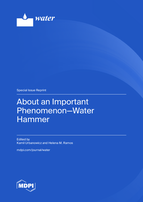About an Important Phenomenon—Water Hammer
A special issue of Water (ISSN 2073-4441). This special issue belongs to the section "Hydraulics and Hydrodynamics".
Deadline for manuscript submissions: closed (30 June 2023) | Viewed by 30211
Special Issue Editors
Interests: water hammer; unsteady pipe flow; transient flow, cavitation; unsteady friction; retarded strain; numerical modelling; analytical solutions
Special Issues, Collections and Topics in MDPI journals
Interests: hydropower; hydraulic transients; pumped-storage; water and energy nexus; hydrodynamic; renewables integration; water-energy efficiency
Special Issues, Collections and Topics in MDPI journals
Special Issue Information
Dear Colleagues,
When flow in pipes under pressure is forced to stop, start or change direction, suddenly, wave propagation associated with the water hammer phenomena takes place. This phenomenon never used to be as popular as it is today. Due to the importance of this issue in regard to practical engineering, the number of works related to this complex topic is systematically increasing from year to year.
From a historical point of view, engineers have contended with water hammer since the invention and use of pipes for transporting liquid from one place to another. Over 2000 years ago, Marcus Vitruvius Pollio had already described the effects of water hammer and cavitation on clay and lead pipelines supplying water to the contemporary water supply systems being built by the Romans. From a mathematical point of view, the description of this phenomenon began with early von Kries, Joukowsky or Allevi works. Joukowsky investigated wave reflections in pipes and the use of air chambers (equalizing tanks and spring-loaded safety valves), and provided a simple formula for a pressure rise (used even today) caused by a fast valve closure.
Today, the discussion of this subject is very extensive. The key issues for water hammer problems may include: single versus multiple phase flow; laminar versus turbulent flow; elastic versus viscoelastic strain behaviour of the pipe material; gaseous versus vaporous cavitation; Newtonian versus non-Newtonian flow; rigid versus flexible pipe walls; and fast (impulsive) versus slow-transient flow. Consideration of the above-mentioned issues should often include selected accompanying phenomena: mechanical energy dissipation due to fluid friction, the occurrence of viscoelastic retarded deformations of the pipe walls due to liquid column separation resulting from cavitation, and fluid–structure interaction.
This Special Issue is dedicated to all problems related to modelling water hammer phenomena, as well to all problems connected with the experimental verification of this specific unsteady type flow. We are open to review your works in which the influences of accompanying phenomena are discussed, as well as those concerning the methods of securing pipe systems against the negative effects of its impact (noise, vibrations, leakages, etc.), and those which just generally broaden our knowledge of water hammer.
Dr. Kamil Urbanowicz
Prof. Dr. Helena M. Ramos
Guest Editors
Manuscript Submission Information
Manuscripts should be submitted online at www.mdpi.com by registering and logging in to this website. Once you are registered, click here to go to the submission form. Manuscripts can be submitted until the deadline. All submissions that pass pre-check are peer-reviewed. Accepted papers will be published continuously in the journal (as soon as accepted) and will be listed together on the special issue website. Research articles, review articles as well as short communications are invited. For planned papers, a title and short abstract (about 100 words) can be sent to the Editorial Office for announcement on this website.
Submitted manuscripts should not have been published previously, nor be under consideration for publication elsewhere (except conference proceedings papers). All manuscripts are thoroughly refereed through a single-blind peer-review process. A guide for authors and other relevant information for submission of manuscripts is available on the Instructions for Authors page. Water is an international peer-reviewed open access semimonthly journal published by MDPI.
Please visit the Instructions for Authors page before submitting a manuscript. The Article Processing Charge (APC) for publication in this open access journal is 2600 CHF (Swiss Francs). Submitted papers should be well formatted and use good English. Authors may use MDPI's English editing service prior to publication or during author revisions.
Keywords
- water hammer
- transient flow
- unsteady friction
- cavitation
- column separation
- retarded strain
- fluid structure interaction
- leakage control
- numerical models
- hydrotransients modelling
- valve manoeuvres
- start-up and shut-down turbomachines







